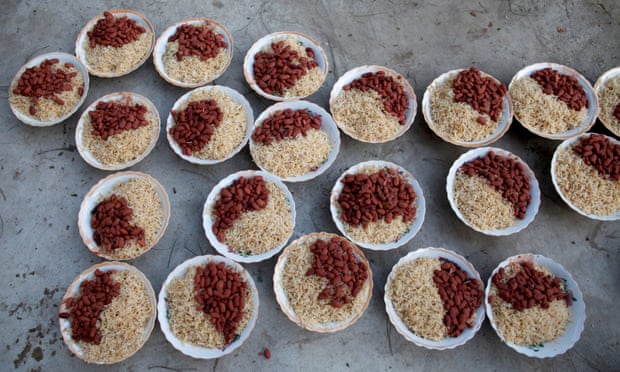The true cost of a plate of food: $1 in New York, $320 in South Sudan

The world’s poorest pay more than a day’s wages for a single plate of food, according to a report from the World Food Programme, which reveals that the same bean stew can cost the average consumer in New York just $1.20, while the price tag is more than $320 in South Sudan.
The research, released to coincide with World Food Day on Monday, underlines the sheer discrepancy of consumers’ purchasing power around the world by measuring the relative cost of food in various countries against a single baseline.
“By adjusting for purchasing power, we shine a stark light on inequalities in the affordability of food,” said WFP’s executive director, David Beasley. “The results are, in many cases, staggering: if you thought a meal was expensive in, say, Norway – well, try Malawi.”
That $1.20 (90p) plate of rice and beans in New York, which is just 0.6% of the New Yorker’s average daily income, costs $8.27 in Guatemala, $27.77 in Nepal, and $72.65 in Haiti.
In South Sudan, the worst-ranking country in the study, the meal costs $321.70, or 155% of a person’s daily wages.
Beasley points to the sheer unaffordability of food – rather than the absence of it – to explain why hunger rages on, particularly in the developing world. Some 795 million people went hungry in 2016, according to WFP, a figure expected to rise this year, due to factors including conflict, political instability, poor infrastructure and climate change.
“Nearly 800 million people went hungry on the planet last year because they simply could not afford to feed themselves, yet we have enough food to feed everyone worldwide: the food we waste could actually feed 2 billion people,” said Francis Mwanza, a London-based spokesperson for the WFP.
“Unless we stop the conflicts, unless we stop the migration of people from their homelands into neighbouring states, unless people have the means to either grow their own food or be able to afford to buy it, people will continue going hungry.”
Even in relatively stable countries, food systems can still be subject to poor communications, transport and storage facilities, the report says. But in nations ravaged by war and instability, drought and famine, food systems can all too easily be at risk because of oppression and abuse of power.
Nearly 50% of Syria’s population needed food assistance in 2016, according to the report, with a basic bean stew estimated at $190.11. Prior to the conflict starting in 2011, Syria was a middle-income country; just five years later, four out of five Syrians are living in poverty, with 75% of the population needing humanitarian assistance.
“These are sobering figures, and I welcome the attempt at simple accountancy to allow such comparisons to be made – it highlights some crucial areas where there is very little resilience to shock,” said Chris Gilligan, co-chair of the Strategic Initiative in Global Food Security at Cambridge University, of the report.
“I’m very concerned that each time we have an epidemic in Africa, or a pest infestation, there is a danger that we start from scratch each time in terms of how we react. We need to get ahead, work out where the infection is likely to come from and where it will go, so that we can … prevent severe losses.”

Leave a Reply